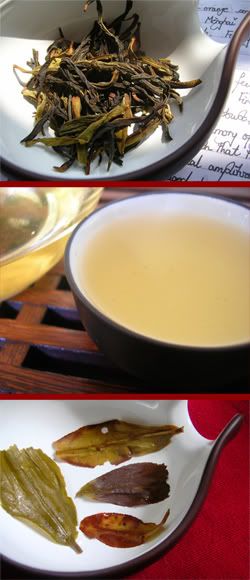
Huangzhi (or huang zhizi) is Cape Jasmine, a pretty flower native to China that we used to believe originated from the Cape of Good Hope, hence the name. Some sites (such as TeaCuppa's from which this samples comes) list this as "yellow branch/twig/sprig scent", which is translating its name literally and ignoring the fact that it is referring to a flower's scent, like most dancong. Rather like shuixian, which is named after the flower (narcissus), not the "water fairy" (after which the flower is named!).
So, prior to drinking, we have in mind light, large-petalled, fairly pollenated flowers, and the usual associations of dancong. Thus armed with such expectations, the actual tea itself comes as a genuine surprise. It's a unique tea, and stands out a mile from other dancong: this is not to say it is necessarily better or worse, but... unique. Truly, this tea has fallen off the edge of the map.
Caledonian Springs @ 90C in 12cl gaiwan; ~5g leaf; 1 rinse
 Dry leaf:
Dry leaf:This is a pretty tea. The striking factor is the sheer immensity of the leaves, which are whole and twisted, and reach up to 7cm in length. Some are dark, but many are pure green. A quiet, sweet aroma of typical dancong light fruits lingers close to the leaves - which is the first and last similarity to conventional dancong.
15s, 15s, 12s, 12s, 20s, 25s:
Odd infusions times, you might well think, and you would be quite right - the unstable nature of the brewing times reflects my great confusion faced with this peculiar tea, in which I experimented with all sorts of factors to see if the tea really is strange. In summary: it is.
The oddness begins with the beidixiang. Primed for flowers and dancong fruits, the smooth, caramel-butter aroma was very unexpected. It was a delight, in fact. It eventually transformed into a white-sugar lengxiang, whereas most are darker, heavier, brown-sugar lengxiang.
 The colour is, as you can see, another oddness in a catalogue of oddities. It is pale yellow, haunted with a little green.
The colour is, as you can see, another oddness in a catalogue of oddities. It is pale yellow, haunted with a little green.The first impression is a pure, uncompromising astringency. Is this kudingcha? An intense, constant harmonic of astringency sings from beginning to end, which is surprising for a dancong.
Around this, the flavours are sweet, floral, and high - they bring to mind large, white petals, and they linger in the aftertaste, sitting happily in the nose for many breaths.
A further oddity, should any further oddity be required, is the chaqi. Now, bearing in mind I am slightly hungover on a Saturday morning, my body might be in an unrepresentative state in which to assess chaqi. I experience truly dizzying chaqi - my head swims in a manner that is nothing to do with an evening of cider and wine. My scalp prickles with heat and energy as the tea courses its way through my body. I blink, trying to determine what has happened.
A little like the 60s Guangyungong, this tea feels like a tonic, or a potion. The kuding-like astringency only strengthens the impression that this is a medicinal preparation of some kind.
The wenxiangbei soon quietens in subsequent infusions, but the tea does not: it is a soldier, and marches on through six infusions with admirable endurance, which one seldom sees in dancong.
Wet leaves:
Huge and strong, autumnal indeed. Hefty amounts of leaf-space are oxidised. I wonder if the astringency derives from some of the pure-green large leaves, an example of which can be seen in the photograph.
Overall:
Like Nietzsche, I cannot abide mediocrity. I prefer extremes (in tea, at least), rather than settle for the crushing blandness of the vast majority of products on offer out there. This tea is certainly extreme, in many ways.
A fascinating combination of unusual aroma, unusual flavour, unusual astringency, and unusual chaqi, this tea makes a statement. Did I enjoy this tea? I honestly cannot say.
It's a baffling leaf - one of a kind. The decision to use a gaiwan was a fortunate one, as this tea surely does not match any pots.

So...where can I find some?
ReplyDeleteadditionally, (and on a wholly unrelated note, I assure you), please be so kind as to e-mail me your mailing address.
theconquestofbread@hotmail.com
regards,
Ian
Hi, Lisa here. I never like HuangZhi, i personally prefer milanxiang one. But my biz partner prefer huangzhi and said it is a much better tea. i never understand why she like it. But ppl actually feedback to us that huangzhi is exceptional and better than milan. But somehow still i prefer milan! :) Maybe huangzhi is just not my cup.
ReplyDeleteWe also tried yulanxiang lately and planning to offer that in future. I love the yulan one.
Ian,
ReplyDeletei. This is a TeaCuppa sample.
ii. Exciting! E-mailed. ;)
Toodlepip,
Hobbes
Dear Lisa,
ReplyDeleteThe milanxiang is certainly much more conventional. I enjoyed the basis flavours of the huangzhixiang, but the astringency:flavour ratio was a bit much - I'll try again with less leaf. It's a crazy tea, and no mistake.
Toodlepip,
Hobbes
I didn't know you had huangzhi sample. Did you get banzhang maocha sample from us? From the leaves picture it can't be the maocha.
ReplyDeleteLisa
Dear Lisa,
ReplyDeleteAs memory serves, there was a banzhang maocha sample. I'll check when I get home at the end of the week.
Thanks, and toodlepip,
Hobbes